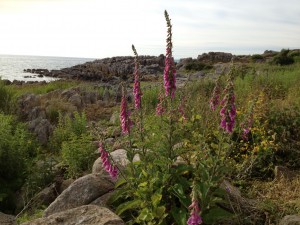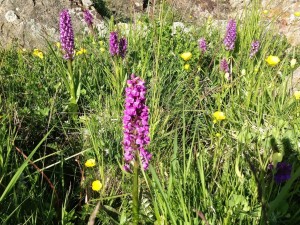 The flora in Allinge is unique and characterised by growing on an expanse of rocky terrain that spreads to the south and north.
The flora in Allinge is unique and characterised by growing on an expanse of rocky terrain that spreads to the south and north.The heat from the rocks combined with the shelter offered by the hollows and crevices along the coastline create growing conditions for plants that are rare in the rest of Denmark.
 The bird's-eye primrose (primula farinosa), a rare and protected perennial, is especially found on Bornholm.
The black spleenwort (asplenium adiantumnigrum) is quite rare, and the only place it grows in Denmark is on Bornholm.
The common concubine (aquilegia vulgaris), sticky catchfly (viscaria vulgaris), warty-cabbage (bunias orientalis), lady’s glove (digitalis purpurea) are all rare plants, but grow in the wild on Bornholm, and there are many other interesting plant species to be found in our rocky fields along the coast.
In the early summer, you can find large dense patches of wild garlic (allium ursinum), which tastes delightful in salads and pestos.
The bird's-eye primrose (primula farinosa), a rare and protected perennial, is especially found on Bornholm.
The black spleenwort (asplenium adiantumnigrum) is quite rare, and the only place it grows in Denmark is on Bornholm.
The common concubine (aquilegia vulgaris), sticky catchfly (viscaria vulgaris), warty-cabbage (bunias orientalis), lady’s glove (digitalis purpurea) are all rare plants, but grow in the wild on Bornholm, and there are many other interesting plant species to be found in our rocky fields along the coast.
In the early summer, you can find large dense patches of wild garlic (allium ursinum), which tastes delightful in salads and pestos.The heath spotted-orchid (dactylorhiza maculata) and elder-flowered orchid (dactylorhiza sambuzina) - typically referred to as “Adam and Eve” they are often found in pairs of red and white - are rare Bornholm orchids that flower along the entire coast in the months of May and June.
Please keep in mind that the lady’s glove and our orchids are protected species. You are not allowed to pluck them, but you are of course free to take pictures.
 Bornholm is also the only place in Denmark where rock whitebeam (sorbus rupicola) grows in the wild, and goat-leaf honeysuckle (lonicera caprifolium) can also be found growing in the wild all the way along the cliff path south of Allinge.
Bornholm is also the only place in Denmark where rock whitebeam (sorbus rupicola) grows in the wild, and goat-leaf honeysuckle (lonicera caprifolium) can also be found growing in the wild all the way along the cliff path south of Allinge.You can also feast on wild cherries which grow all around the area in the early summer.
Fruit-bearing fig and mulberry trees are also quite common due to the island’s long late summer.
The rocks and water retain the summer heat well into September, which is practically a summer month on Bornholm.



